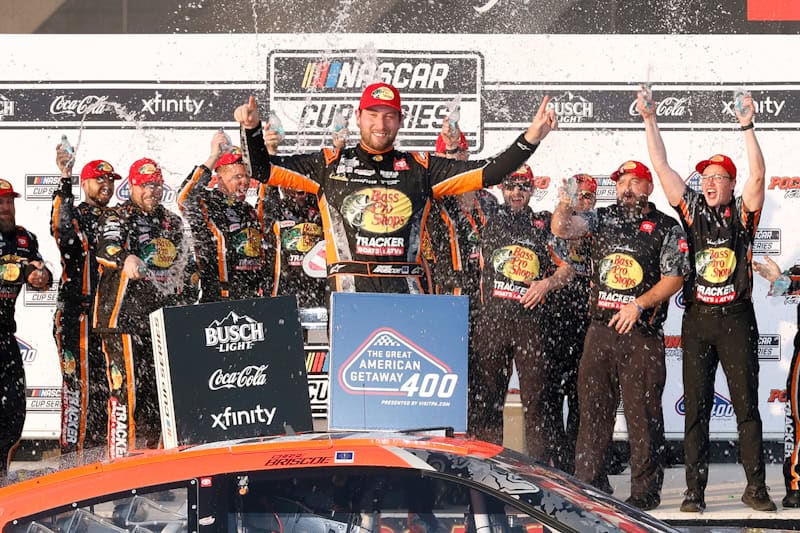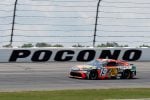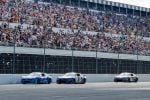Make it 11 different race winners in the Cup Series in 2025.
Chase Briscoe saved just enough fuel to win The Great American Getaway 400 at Pocono Raceway on Sunday (June 22), his first win for Joe Gibbs Racing and the third overall of his Cup Series career.
After an over two-hour rain delay, the term “fuel mileage” was on the lips of all team members before the green flag even waved all the way to the checkered. So, which teams called the strategy right and which ones botched it? Let’s discuss.
Chase Briscoe Passes Fuel Conservation Test
After a short and clean stage one, the fuel strategies got spread out during stage two thanks to several cautions for incident.
No. 19 crew chief James Small called Briscoe to pit road for his stage two pit stop on lap 79. Thanks in part to another caution on lap 83, Briscoe shuffled to the front to take the stage two win.
From there, every team needed one more pit stop to make it to the scheduled distance, and they were doing what they could to need as little fuel as possible to have the quickest final stop.
Austin Cindric, Josh Berry and Alex Bowman commenced the final pit cycle under green on lap 118. Briscoe came to the service of his crew one lap later, getting in and out with a quick 11-second stop, but perhaps it was too quick. Small came on the radio urging Briscoe to maximize his fuel savings.
When the race restarted with 30 laps left, Briscoe took the lead and went right to work saving fuel, letting off the throttle sooner into the corners. The effort paid off, with Briscoe having almost a full mile-per-gallon better mileage than runner-up Denny Hamlin. As a result, Briscoe saved enough to see the checkered flag.
“To be honest, that’s the first time I’ve really been in that situation before,” Briscoe said during the Amazon Prime Video post-race show. “I knew that I was saving quite a bit. Whenever we did the pit stop, I knew that I screwed up and went too early, so I instantly started saving fuel.”
No. 6 Team’s Multiple Mistakes
While Briscoe and Small’s pit strategy panned out for the No. 19, the same could not be said for Brad Keselowski and his No. 6 RFK Racing crew chief Jeremy Bullins. The No. 6 team made two costly mistakes that cost them a chance to contend for the win.
The first issue came on lap 57 when Keselowski came down pit road under caution. There was just one problem: pit road was closed. That sent the 2012 Cup Series champion to the rear of the field for the ensuing restart. Bullins took responsibility, stating that he did not know that the red light was on indicating pit road was closed.
While the first miscue was on the crew chief, the second one was on the driver. During the final round of pit stops during stage three, Keselowski opted to stay out another lap or two to ensure he had enough fuel as well as slightly fresher tires than most of the field.
However, just before Keselowski was going to pull off for his pit stop, Mexico City winner Shane van Gisbergen spun out off of turn one with 36 laps to go for what proved to be the race’s final caution. Keselowski came down pit road under caution, but his chances to win were gone, rallying to ninth over the final run.
“We got the lead there in the first stage and felt like we were in control,” Keselowski said. “We lost control of the race early with the pit road penalty, and I thought we recovered really, really well from that and got up to third our fourth there. We kind of had this strategy to run longer than the lead pack there, and the yellow came out in the middle of the cycle.”
Scary Moment for No. 88 Crew Member
Auto racing is an inherently dangerous sport not only for the drivers, but also for the pit crews who service the cars.
That fact was on full display during yellow flag pit stops on lap 46. AJ Allmendinger came into his pit stall a little too hot in his No. 16 Kaulig Racing Chevrolet, getting a piece of the tires his crew was carrying to the right side of the car.
The tire also deflected off of the No. 88 of van Gisbergen before hitting JP Kealey, the rear tire changer on the No. 88 crew. Kealey was knocked down briefly before getting back up and helping complete the No. 88’s pit stop. Thankfully, Kealey was okay and able to finish the race, but it was a scary moment and a reminder of the risk these pit crew members take every week.
Pit Road Penalties
In addition to Keselowski’s penalty mentioned above, there were two other notable pit penalties at The Tricky Triangle on Sunday.
During the first round of pit stops following stage one, Kyle Busch got nabbed for speeding on pit road in his No. 8 Richard Childress Racing Chevrolet. The penalty was just one part of the nightmare weekend for Busch, qualifying 26th, spinning out on lap 83 and ultimately winding up 20th at the end of the day.
Ryan Blaney had a pit road speeding penalty of his own on lap 58, sending him to the tail of the field. Unlike Busch, Blaney did bounce back, overcoming starting at the back, the speeding penalty and a failure with his cool suit to taking the checkered flag in third.
“I think after having to start at the back and the mistake I made, I feel like we recovered really well and our car was fast enough to do it,” Blaney said post-race.
Look Ahead to Next Week
The NASCAR Cup Series goes superspeedway racing this Saturday, June 28 with the running of the Quaker State 400 at EchoPark Speedway. Coverage begins at 7 p.m., and it will be the first of five straight Cup races on TNT.
The Cup Series’ second trip to the newly rechristened track will also be the first race of the first annual In-Season Challenge, a single-elimination, tournament-style competition between 32 Cup drivers. As the next five races unfold, it will be interesting to see if the In-Season Challenge has any impact on how teams call their pit strategy.
For some fans, big weekends like this are also a cue to explore online betting options beyond the track. NASCAR wagers continue to grow, and with the in-season tournament coming up, there’s no better time to get involved!
Andrew Stoddard joined Frontstretch in May of 2022 as an iRacing contributor. He is a graduate of Hampden-Sydney College, the University of Richmond, and VCU. He works as an athletic communications specialist at Eastern Mennonite University in Harrisonburg, Va.






